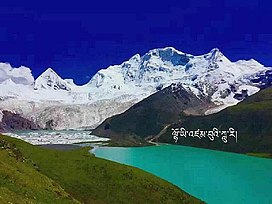Sepu Kangri
 From Wikipedia - Reading time: 6 min
From Wikipedia - Reading time: 6 min
| Sepu Kangri | |
|---|---|
 | |
| Highest point | |
| Elevation | 6,956 m (22,822 ft)[1] |
| Coordinates | 30°54′15″N 93°47′09″E / 30.904103°N 93.785923°E |
| Geography | |
| Country | China |
| Autonomous region | Tibet |
| Prefecture | Nagqu |
| County | Biru County |
| Parent range | Nyenchen Tanglha Mountains |
| Climbing | |
| First ascent | October 2nd, 2002 by Carlos Buhler and Mark Newcomb |
| Sepu Kangri | |||||||
|---|---|---|---|---|---|---|---|
| Traditional Chinese | 色浦崗日 | ||||||
| Simplified Chinese | 色浦岗日 | ||||||
| |||||||
| Sapu Mountain | |||||||
| Traditional Chinese | 萨普神山 | ||||||
| Simplified Chinese | 萨普神山 | ||||||
| Literal meaning | Sapu holy mountain / Sapu sacred mountain | ||||||
| |||||||
The Sepu Kangri (Tibetan: བསངས་ཕུ་གངས་རི, Wylie: bsangs phu gangs ri, THL: sang pu gang ri; also Sapu Mountain from Chinese) is a mountain in Biru County, Nagqu prefecture, Tibet Autonomous Region. The mountain is 285 kilometres (177 mi) east-northeast of Lhasa and 178 kilometres (111 mi) east-southeast of Nagqu Town. With a height of 6,956 metres (22,822 ft), it forms the highest point in the eastern part of the Nyenchen Tanglha Mountains. The full name of the mountain is Sepu Kunglha Karpo, meaning "white snow god".[2]
The mountain is sacred in Tibetan Bon tradition. The mountain is referred to as (Tibetan: ལྷོ་ཡི་འཛམ་བུ་ཀླུ་རི, Wylie: lho yi 'dzam bu klu ri) in that context.[3] There is a Bon monastery that is more than half millennium old in the valley below.[3][4]
Climbing history
[edit]Chris Bonington and Charles Clarke explored the mountain in 1996. In the following two years they tried unsuccessfully to climb Sepu Kangri.[4][5][6][7]
Finally, on October 2, 2002 Carlos Buhler and Mark Newcomb succeeded in first ascent.[6][7][8]
References
[edit]- ^ Sepu Kangri, China at Peakbagger.com
- ^ Bonington, Chris (1999). "Courting the Great White Snow God" (PDF). The Alpine Journal. Vol. 104. p. 23. ISBN 0948153598. Retrieved 7 March 2022.
In the next couple of days we learned that this was a holy mountain, that its full Tibetan name was Sepu Kunglha Karpo, which means the White Snow God.
- ^ a b Dondrup Lhagyal; Phuntso Tsering Sharyul; Tsering Thar; Charles Ramble; Marietta Kind (2010). Samten G. Karmay; Yasuhiko Nagano (eds.). "A Survey of Bonpo Monasteries". THL. Retrieved 7 March 2022.
'Bri ru rdzong - gSa' mda' bon Monastery ... The monastery was founded by Zhu btsun gYung drung khri 'od in 1465. ... The area has a mountain called Phu ru lho yi 'dzam bu klu ri ... These are regarded as two of the Thirteen Treasures of gSa' (snow leopard). ... They are places of outstanding sacredness where teacher Kun tu bzang po meditated and bestowed blessings.
- ^ a b Bonington, Christian (1998). "Asia, Tibet, Sepu Kangri, Attempt". Alpine Climbing Group. Retrieved 7 March 2022.
These peaks are sacred; the Samda monastery, an 800-year-old Bonpo fortress shrine presently housing 40 monks, is a day's journey below them.
- ^ Tibet's Secret Mountain: the Triumph of Sepu Kangri AAJ, 2000
- ^ a b "AAC Publications - Sepu Kangri". publications.americanalpineclub.org. Retrieved 2020-09-30.
- ^ a b "Himalayan Index - Results of Search by Group". alpine-club.org.uk. Retrieved 2020-09-30.
- ^ "AAC Publications - Asia, Tibet, Nyainqentanglha Range, Sepu Kangri, First Ascent". publications.americanalpineclub.org. Retrieved 2020-09-30.
 KSF
KSF